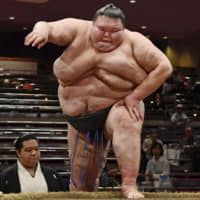The first thing that comes to mind when people think of sumo is the size of the participants.
While the height of most wrestlers doesn't generally exceed that of athletes in many other sports, the weight, especially at the top level, is far greater.
Offensive linemen in football probably come closest. Weighing 140 kg and standing 195 cm tall on average, the modern day NFL O-Line is filled with athletes whose size rivals rikishi.
Thanks to rikishi like Enho, Terutsuyoshi and Ishiura, the current makuuchi division average height is also quite a bit shorter at 183 cm.
Sumo's top division, however, is 24 kg heavier on average, which is a reflection of the fact that wrestlers don't have to run and can focus even more on building a body that generates explosive force in a confined space.
The record holder in the top division was former ozeki Konishiki, who tipped the scales at 285 kg. To put that in perspective, it's a full 58 kg heavier than the current heaviest rikishi Ichinojo, who weighs 227 kg.
Konishiki wasn't the heaviest of all time, though. That title goes to Orora.
The Russian, who never went past sumo's third-highest division, hit 294 kg just prior to his retirement last year.
Even that pales in comparison with the biggest sumo wrestler of all time.
Emmanuel Yarbrough, who died in 2015, held the Guinness World Record for the heaviest athlete. Standing 203 cm and reaching a peak weight of 400 kg, Yarbrough had more success in the ring than any other American amateur sumo wrestler.
The 1995 world champion, a Virginia native, was the first ever non-Japanese or Mongolian gold medalist.



